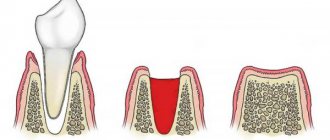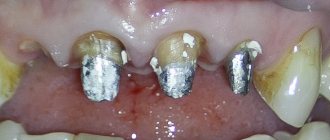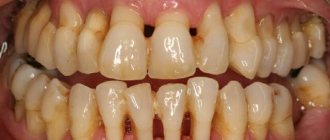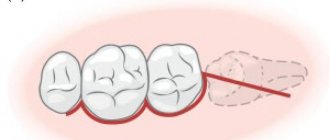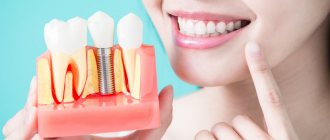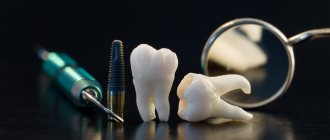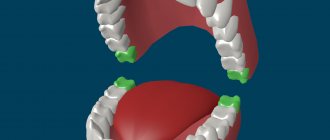Indications for implant removal
- Rejection of the structure mainly develops within six months after implantation.
- Peri-implantitis or perimucositis - the first is accompanied by a loss of jaw bone against the background of inflammation of the soft tissues, the second occurs without loss of tissue volume.
- Excessive load on the implant - occurs due to violation of the installation protocol.
- Incorrect position or defective implant is extremely rare.
- End of service life - for models with limited serviceability.
In our clinic, implant installation is carried out strictly in accordance with surgical protocols, using the most reliable systems in the world, Nobel Biocare (USA), with a lifetime warranty from the manufacturer and almost zero risk of rejection. If an unpleasant situation does arise, we guarantee free dismantling of the structure.
Reasons for deletion
There are only a few factors that, as a result of their influence, will require the removal of an artificial root and a crown simulating a tooth. Among them:
- end of service life of the installed implant;
- the product did not take root for some reason or due to the individual characteristics of the body, it was rejected;
- increased load on the Adin implant, which led to its loosening;
- the formation of an inflammatory process at any stage of engraftment or operation, which can begin either through the fault of the patient or through the negligence of the prosthetist;
- presence of problems with the dental structure: poor fixation, poor-quality materials, inappropriate size, etc.;
- wrong position, i.e. the sample can be installed crookedly or, on the contrary, visible from under the soft tissue of the gums.
One of the most important reasons is foreign body rejection, which can occur due to a number of negative factors affecting it. In this case, removal of the dental implant will be required and, depending on the underlying cause, reimplantation or, if necessary, drug therapy and a restoration procedure will be performed.
How are dental implants removed?
After the doctor, based on X-ray data, decides to remove the dental implant, a planned operation is scheduled. Removal of dental implants occurs in this way:
- Anesthesia is performed.
- The temporary or permanent crown is removed.
- The gum is incised to provide access to the artificial root.
- The implant is removed.
- Sutures are placed (if re-implantation is planned, bone material is added before suturing).
Indications
Implant removal is indicated:
- in the absence of engraftment within 3-6 months,
- inflammatory process in the jaw and tissues surrounding the titanium rod,
- overloading the structure,
- incorrect position of the implant,
- the end of the period of use of the structure declared by the manufacturer.
The most common reason for removing dental implants is failure. This problem can be caused by:
- exacerbation of chronic diseases,
- weakening of the immune system,
- improper preparation and conduct of the operation,
- jaw injuries.
The following signs indicate possible rejection:
- severe pain that does not go away even when taking analgesics,
- swelling and bleeding gums,
- discharge of pus.
Sometimes the implant may need to be removed immediately after it is placed. The procedure is necessary if severe bleeding occurs during the operation to implant a titanium rod. In such cases, the structure is removed and additional treatment is carried out.
Dental implant removal cost
The cost of removing a titanium rod is equivalent to removing a complex tooth. However, a number of factors are taken into account that can increase the final amount. This is bone grafting, plastic surgery of soft gum tissue. Additional procedures are paid separately.
If the implantation was carried out in a clinic and the removal is performed in the same clinic, the procedure is free under warranty . If the patient came from another clinic, he needs to pay for the service. The price will depend on the clinical picture.
Implant removal
If drug therapy does not help, they resort to removing the pin. This cannot be delayed; complications are possible - an infectious disease that affects the bone marrow (osteomyelitis). This form of exacerbation can lead to tragic consequences.
Modern operations are performed absolutely painlessly under local anesthesia (possibly under general anesthesia). The procedure itself is carried out in stages:
- The dentist removes the crown.
- The gum is cut.
- is removed .
- Treatment of the oral area with antiseptic agents.
- Infected tissue is removed.
- The incision is quickly sutured.
- Follow up doctor's recommendations.
After the operation, the patient must strictly follow all medical prescriptions, as well as the usual principles of prevention: take care of the oral cavity, go to the clinic for routine examinations.
After complete restoration of the operated area, you can undergo re-implantation, it all depends on the recommendations of the attending physician. Sign up
Why does the implant not take root?
Physiological rejection
Occurs as a result of the patient’s body’s rejection of implants for the following reasons:
- allergic reaction to components of the dental system material;
- weakened immune system;
- chronic diseases in the acute stage;
- trauma to the jaw bone at the site of rod insertion;
- installation of an implant without taking into account the individual characteristics of the patient’s dental apparatus.
Doctor's mistakes
In clinics that value their reputation, such situations rarely happen:
- unsatisfactory diagnosis and sanitation of the oral cavity at the preparatory stage for implantation;
- neglect of the osteoplasty procedure for bone tissue atrophy;
- incorrect selection of the implant model, location in the jaw, unreliable fixation;
- violation of sterility;
- premature load on the structure, unacceptable in a particular situation;
- use of rods of questionable quality.
Patient errors
We make sure to give recommendations to the patient after implantation. If he was irresponsible in their implementation, the implant may be rejected due to:
- getting infections into the mouth through unwashed hands;
- non-compliance with the rules of daily oral hygiene;
- failure to follow postoperative recommendations for taking antibiotics and other drugs;
- smoking, drinking alcohol immediately after implantation of a titanium rod;
- increased physical activity;
- thermal procedures (bath, sauna, hot bath, overheating under the sun);
- hypothermia;
- neglect of doctor visits for examinations and preventive office procedures.
Causes and symptoms for implant removal
The indication for removal of the structure is the absence of its engraftment to bone tissue. If there is no movement for osseointegration within 6 months, the implant should be removed. The removal procedure is quite simple; there are no contraindications for implantation in the future.
Peri-implantitis or perimucoside are pathological conditions that can appear after the procedure or during the healing stage. The main reason for the development is the patient’s failure to comply with the norms and rules that ensure the course of the postoperative period.
There are complications that arise due to the fault of the doctor. The reason for this is improper installation of the structure, or the use of an expired implant.
The indication for removal of the structure is the absence of its engraftment to bone tissue
The list of reasons for design rejection includes:
- exacerbation of chronic pathologies (the engraftment process is disrupted as a result of symptoms of chronic rhinitis against the background of pressure disturbances in the cavities);
- non-compliance with the dentist’s recommendations in the postoperative period;
- incomplete compliance with the rules of oral hygiene and implant care;
- immune system disorders;
- jaw trauma.
The list of medical errors that can cause disruption of the engraftment process is as follows:
- use of low quality equipment and tools;
- insufficient cooling leading to bone overheating;
- non-compliance with the rules of antiseptic treatment of the implant and the patient’s oral cavity;
- contraindications to the intervention;
- use of economy-class structures made of low-quality titanium alloys.
The reason for the disruption of the engraftment process may be a discrepancy between the width of the hole and the diameter of the structure. If the hole is of significant size, artificial loosening of the root is possible. If the hole is too small, there is a risk of bone injury.
Rejection symptoms
- Bleeding, redness of the gums;
- swelling;
- pain;
- increased body temperature;
- mobility of the artificial root;
- detachment of soft gum tissue by more than 1 mm;
- headache;
- difficulty chewing food;
- bad breath;
- weakness;
- the appearance of fistula tracts in the subgingival part;
- violation of the symmetry of the oval of the face.
Bleeding, swelling of the gums, pain and fever are normal in the first week after implantation. If they persist and other unpleasant signs are added, you should urgently consult the doctor who performed the operation.
How to avoid deletion
If there are acute indications for the removal procedure, it should not be abandoned. The inflammatory process can spread to the entire oral cavity and cause the development of various lesions of the dentition.
To avoid deletion, you should follow simple rules
It is possible to reduce the likelihood of removal. To do this, the patient must follow simple rules:
- provide the doctor with information about the presence of various complications, for example, slow regeneration processes, sluggish blood clotting - the prescription of certain drugs can reduce the likelihood of complications to a minimum;
- the physician should be notified of the presence of allergic reactions to medications and metals;
- compliance with the rules for oral care in the preoperative and postoperative period;
- carefully select a dental clinic; it is better to go to a private institution with a high reputation;
- undergoing regular dental checkups during the recovery period.
At the first suspicion of the development of complications, you should consult a doctor without delay. Timely treatment of the inflammatory process can reduce the risk of needing removal.
How to avoid complications
It is possible to prevent the removal of a dental implant. Negative consequences are minimized when:
- a responsible approach to the issue of choosing a clinic - it is important to find out about certification for the right to conduct such operations, the qualifications of doctors, and familiarize yourself with the terms of the contract;
- maintaining sterility and hygiene during the rehabilitation period after implantation;
- quitting smoking and alcohol in the first 7-10 days;
- minimizing physical activity;
- excluding solid foods and hot foods from the diet;
- refusal of thermal procedures;
- Regular visits to the clinic in accordance with the drawn up treatment plan.
Implantation is a serious surgical procedure, and during the recovery phase it is important to follow recommendations regarding nutrition, hygiene, and medication.
Can dental implants be removed?
The question of whether it is possible to remove dental implants is asked by almost every second patient at a dental clinic. It seems to many that a titanium pin, after implantation into the jaw, literally merges with the bone. However, in reality, removing the implant will not be difficult for an experienced specialist. The procedure is traumatic and requires the doctor to have high manual skills, so the well-known saying “Breaking is not building” does not apply here. In any case, before talking about the nuances of removing implants, you need to understand why such situations arise.
When should it be deleted?
When the first unpleasant symptoms appear, which indicate an abnormal position or vital activity of the implant, urgent assistance from an implantologist or dentist is required. When side effects do not go away within two or three weeks, and proper treatment has not been carried out, removal of the artificial structure will be necessary in any case. However, if you seek the help of a doctor in time when the first defects and complications appear, you can get by with a little drug therapy.
If the rejected or problematic structure is not removed in a timely manner, this will lead to the destruction of a section of the jawbone. This combination of circumstances will lead to the fact that repeated implantation will be impossible without sinus lifting.
